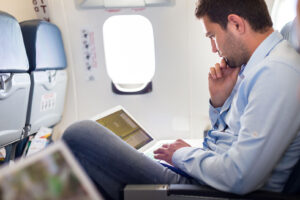Airline WiFi: Standard Equipment on All Flights?
Once a perk, internet access has become ‘must-have’ for business, leisure travelers
By Jesse Geleynse
Published August 9, 2021
Read Time: 4 mins
It was a different era when Rob Sinclair began traveling for work.
That was back in 2007, when iPhones hadn’t hit the market and GoGo in-flight WiFi had yet to make its commercial debut.
Since then, Sinclair, the corporate design technology manager at Pittsburgh-based Civil and Environmental Consultants, Inc., has seen in-flight internet access grow from infancy to ubiquity.
“It’s pretty uncommon to get on a plane now where it’s not equipped with WiFi, whereas five years ago it was probably half and half,” he said. “I think with the technology that’s out now, once all the airlines catch up with their fleets and the newer technology, you will essentially have broadband internet in the air.”
Driven by demand from both business professionals and leisure fliers, quality WiFi access has become a “must-have” for airlines, though it’s hardly a huge moneymaker. As smartphones have proliferated and the technology has improved, in-flight WiFi has come to be “as expected by today’s traveler as the bar cart,” according to Henry Harteveldt, president of San Francisco-based Atmosphere Research Group.
“Especially for the younger generation of travelers who represent the future of the airline industry’s customer base, (airlines) know they have two choices: offer a compelling WiFi product or risk losing your customers to airlines that do,” Harteveldt said.
How it works
Airplanes utilize one of two technologies to deliver WiFi: air-to-ground systems and satellites. In air-to-ground, WiFi is beamed up to the plane from cell phone towers and received by antennas on the underside of the plane. This was the technology used by GoGo when it debuted in 2008.
With satellite WiFi, a satellite in orbit receives signals from the ground and transmits them to antennas on the top of the plane. Since the signal is coming from orbiting satellites, rather than ground-based cell phone towers, satellite WiFi allows passengers better access over bodies of water and barren tracts of land.
Satellite WiFi also allows gate-to-gate access, rather than requiring airplanes to cross the 10,000-foot altitude threshold, as is the case with air-to-ground systems.
Air-to-ground allows users to check emails and do some browsing, but usually isn’t suitable for streaming. The bandwidth provided by satellites can support streaming, so many airlines are investing in plane upgrades to support satellite WiFi.

Airplanes utilize air-to-ground systems or satellites to deliver WiFi to passengers. (Stock image)
Some in the entrepreneurial class are looking to cash in on the satellite technology. SpaceX founder Elon Musk’s Starlink satellite internet company, which currently provides broadband access to rural areas, is reportedly in talks to provide internet to commercial aircraft.
But air-to-ground isn’t going away anytime soon. It’s still used extensively in many areas worldwide, and the current technology needed for satellite WiFi is too heavy and expensive for smaller, regional aircraft.
“I’m sure the engineers are exploring ways to make hardware smaller and lighter and with that, less expensive to acquire and (require) less fuel,” Harteveldt said. “Smaller lighter hardware would also be better on mainline aircraft.”
The race to upgrade
Sinclair gets free WiFi when he flies Southwest and typically pays for access on other airlines if the flight is an hour or more. WiFi is the new reality for business travelers in the 21st century, he said.
“Everybody is connected at all times whether it’s for personal use or business use,” Sinclair said. “You definitely feel like you’re missing something when you’re not connected.”
Airlines are focusing their upgrade efforts on flights longer than 90 minutes, while offering different options for fliers with different price points. For example, WiFi remains free on JetBlue domestic flights, while Delta and Alaska offer free messaging through their in-flight WiFi systems, and charge fees for more extensive access.
For Harteveldt, the ultimate litmus test is seeing the ultra low-cost carriers getting involved.
“Nothing shows how WiFi has become such a core mainstream amenity for airlines to offer than Spirit Airlines announcing they would add WiFi to their aircraft,” Harteveldt said, referring to the a la carte bargain airline.
There are also practical reasons for airlines to invest in stronger WiFi, he said. A better connection helps with real-time credit card validation for on-board purchases, thereby reducing the opportunity for fraud.
And stronger WiFi can be used to transmit airplane sensor data to airplane and engine manufacturers, alerting them to potential problems that can be addressed in real time, Harteveldt said.
But there is a limit to how far airlines will go to invest in their WiFi infrastructure, he said.
“The sky may have no limits, but I think there is a point where airlines are going to say… (that) investing in WiFi simply gives the airline no business advantage, no economic return, no increased passenger preference, no added revenue.”
Instead, the carriers will focus on better hardware, he added. “That will be smarter and or lighter, and that will help reduce fuel burn.”
Watch
This Next
Read
This Next





